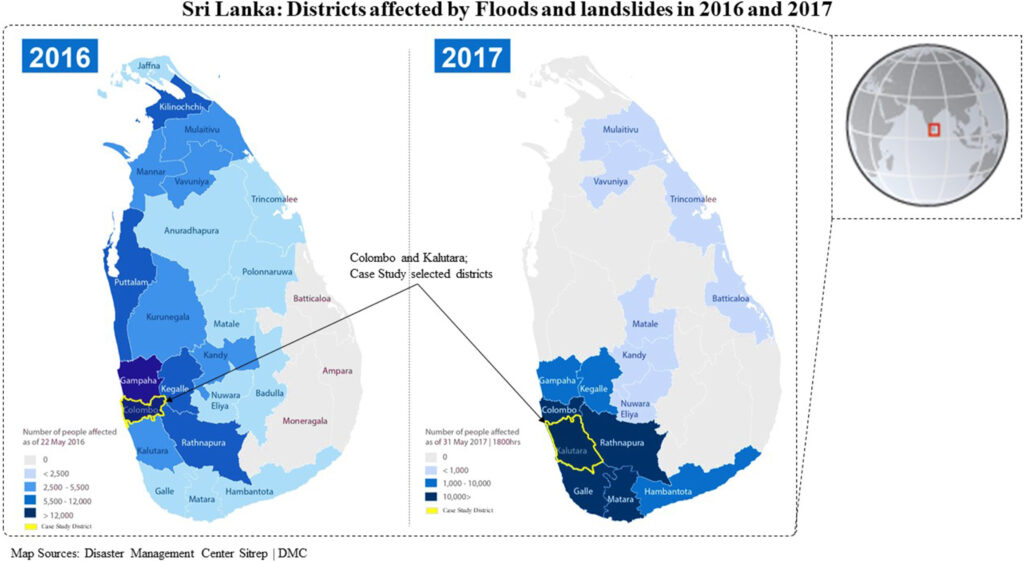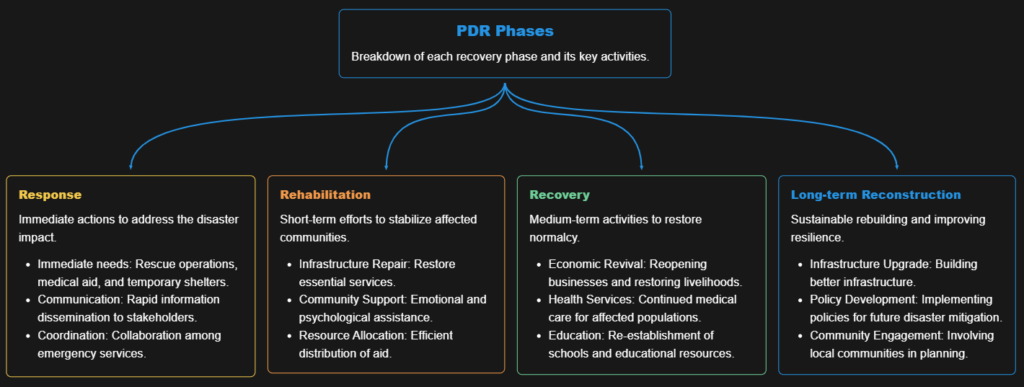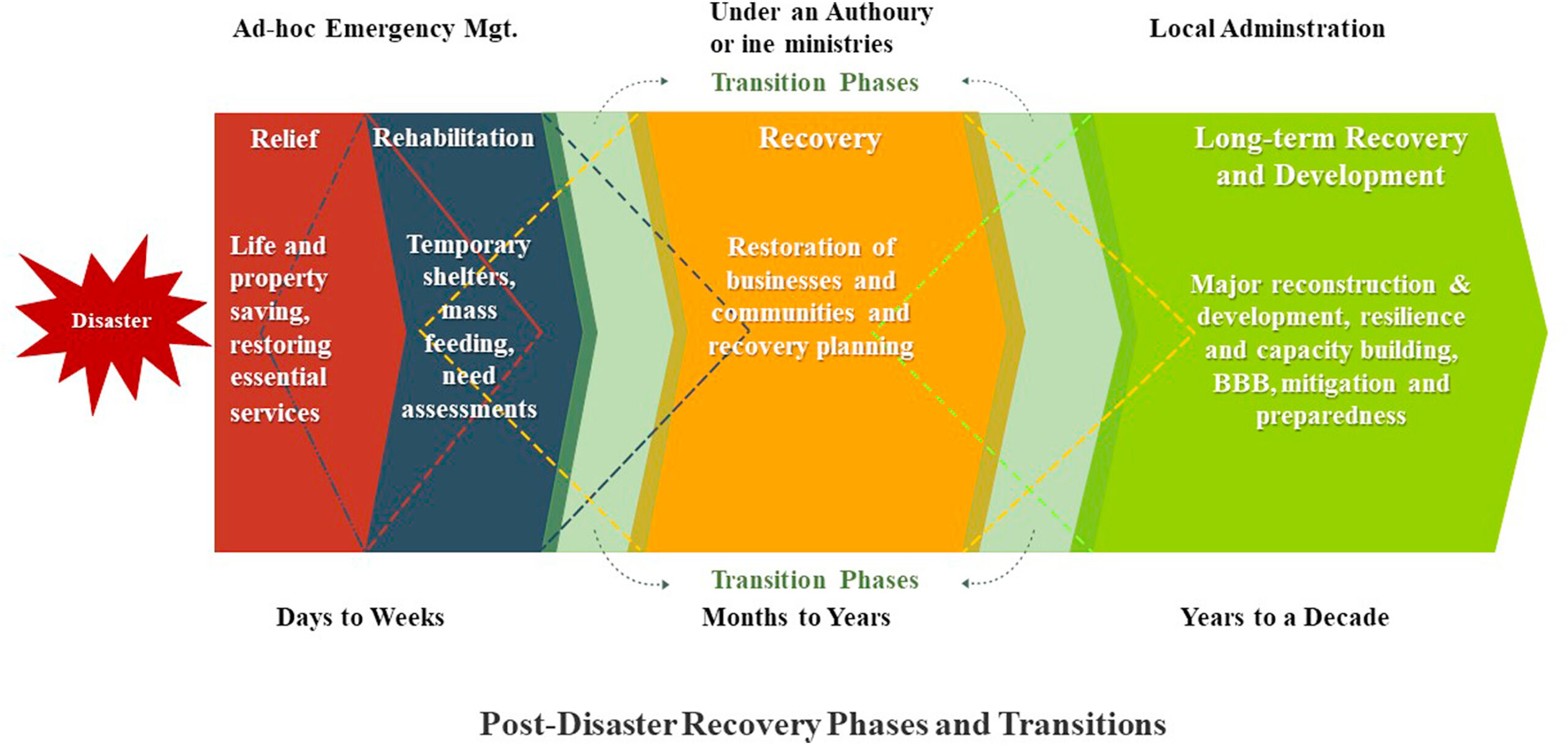Abstract
This research publication aims to understand the challenges arising in each post-disaster recovery (PDR) phases and how they contribute to overall recovery progress. It further investigates the transition of recovery from one phase to the subsequent phases of PDR. The 2016 and 2017 floods and landslides in Sri Lanka were used as the case study focusing on the two affected districts, Colombo and Kalutara. An in-depth study was conducted to explore the PDR phases from response to long-term reconstruction and development following the disaster events.
Key Highlights
– Disasters have become a common phenomenon worldwide, with climate change exacerbating the impacts of natural hazards [1]. – In the year 2022, a total of 387 disaster events were reported [2]. This number of events is higher than the annual average of 370 disaster events for the period of 2002–2021 [2]. – This study has highlighted how challenges in each PDR phase of the chosen case study culminated in failures in the long-term recovery. – A case study research methodology approach was applied to obtain an in-depth understanding of PDR phases following the 2016 and 2017 flood and landslide events in Sri Lanka. – The study shows that state ministries, departments, and local non-governmental organisations (NGOs) lacked a practical understanding of the recovery transition. – Regarding the recovery transition, there was only one transition from response and rehabilitation to the recovery phase occurred. – No evidence was found for the second recovery transition from recovery to the long-term reconstruction and development phase. – Similar trends were found in both case studies during the post-disaster recovery (PDR) phase, the challenges were more significant in the Kalutara district of Sr Lanka. – A recovery transition plan must be implemented through continuous training programs for local government officials, community leaders, and local NGO volunteers to enhance public awareness and skills regarding all aspects of PDR. – The findings of this research make an original contribution to the limited scholarship on the implications of individual PDR phases on long-term recovery.
Introduction
This research publication explores the challenges and progress of post-disaster recovery phases, focusing on the 2016 and 2017 floods and landslides in Sri Lanka’s Colombo and Kalutara districts.
Ali and Mannakkara (2024) report that disasters are increasing due to climate change, with 387 events reported in 2022, higher than the annual average. Challenges in post-disaster recovery were more significant in the Kalutara district in Sri Lanka. The study emphasizes the need for capacity development, effective coordination, and community engagement to enhance disaster governance and achieve long-term reconstruction and development. Key challenges identified include lack of capacity development, inadequate data management, and insufficient community participation. The study recommends creating robust data management systems, establishing a recovery authority, and improving coordination and community engagement for successful post-disaster recovery.

Research Summary
Snapshot; This study examines the challenges faced during post-disaster recovery (PDR) phases in Sri Lanka, highlighting the need for capacity development, effective coordination, and community engagement to enhance disaster governance and achieve long-term reconstruction and development.
Study Subjects; The study focuses on the 2016 and 2017 floods and landslides in Sri Lanka, specifically in the two affected districts, Colombo and Kalutara.
Key Findings; The study found that challenges in each PDR phase culminated in failures in the long-term recovery, with similar trends found in both case studies during the PDR phase, and more significant challenges in the Kalutara district. The study found several factors in different PDR phases hindering long-term recovery.
They include a lack of communication and coordination mechanisms among key stakeholders in the response phase, and limited capacity and resources of local authorities in the rehabilitation phase. The challenges in recovery and long-term reconstruction and development phases were disaster governance, collection and management of data and information, and low level of inter-agency collaboration. Some factors were recurring and continually hindered the PDR process and had a larger impact in Kalutara than in the Colombo district.
Lack of capacity development at all levels leads to ineffective coordination and community engagement. Inadequate data and information management, hindering decision-making and resource allocation. Insufficient community participation and engagement, leads to poor understanding of cultural issues and needs. The project handover and project transfer implementation were the least valued, both below 50 %.
Regarding the transition of recovery, there was only one transition from response and rehabilitation to the recovery phase occurred. No evidence was found for the second recovery transition from recovery to the long-term reconstruction and development phase.
The study aims to examine the PDR phases, from the first response phase to the long-term reconstruction and development phase, following the 2016 and 2017 flood and landslide events in Sri Lanka. This study specifically investigated the recovery transition to the subsequent phases in PDR through two on-field case studies.

Methods
The study used a case study research methodology approach to obtain an in-depth understanding of PDR phases following the 2016 and 2017 flood and landslide events in Sri Lanka, specifically in the Colombo and Kalutara districts. To obtain an in-depth understanding of PDR phases, the study employed semi-structured interviews with disaster management professionals involved in various phases of post-disaster recovery in different capacities.
Results
The study found that the PDR transitioned into the subsequent recovery phase, but it was disorganized and encountered communication, coordination, and funding challenges.
The study identifies several key challenges in PDR phases, including lack of capacity development, inadequate data and information management, insufficient community participation, inefficient use of resources, limited coordination and communication, lack of clear leadership, inadequate preparedness and mitigation measures, and limited availability of accurate data.
The study reveals that the response and rehabilitation phase was hampered by a lack of coordination, communication, and resources, while the recovery, long-term reconstruction, and development phases experienced challenges related to resource capacity scarcity and insufficient community participation.
Conclusions
The study concludes that challenges in each PDR phase culminated in failures in the long-term recovery, and that a lack of clear communication and cooperation among multiple entities engaged in the response and rehabilitation phases have been frequently highlighted as key challenges in PDR studies.
- The study concludes that capacity development, effective coordination, and community engagement are crucial for enhancing disaster governance and achieving long-term reconstruction and development in PDR phases.
- The study concludes that capacity development, effective coordination, and community engagement are crucial for enhancing disaster governance and achieving long-term reconstruction and development in PDR phases.
- The study concludes that the recovery transition fails to obtain much-needed attention from PDR planning and decision-making stakeholders, and that failing to transition into the long-term phase has contributed to PDR failure.

Future Work
- Future research should aim to address the limitations of this study by including a larger geographic area, a more substantial and diverse stakeholder sample size to enhance the comprehensiveness and applicability of the findings.
- Future research should focus on developing effective coordination and information exchange mechanisms, enhancing community participation and engagement, and improving data and information management to support PDR phases.
Practical Applications
These findings will assist in planning future post-disaster recoveries in the region to ensure issues are anticipated, and proper planning is done ahead of time. The goal is to tackle the issues impeding long-term recovery in each PDR phase to allow a smooth and successful transition into the long-term phase.
- The study recommends creating robust data management systems and protocols to collect, store, and share among stakeholders to enhance transparency and facilitate coordinated PDR efforts.
- The study’s findings have practical implications for disaster governance and PDR phases, highlighting the need for capacity development, effective coordination, and community engagement to enhance disaster governance and achieve long-term reconstruction and development.
- The study recommends the establishment of a time-bound recovery authority with dedicated funding and resources, robust data management systems, and regular assessments and evaluations of PDR plans and their implementation.
Builds on previous work; A lack of clear communication and cooperation among multiple entities engaged in the response and rehabilitation phases has been frequently highlighted as key challenge in PDR studies. Furthermore, the availability of accurate data in the planning stage in the most affected areas has also been highlighted in other research.
Contributions
This study has highlighted how challenges in each PDR phase of the chosen case study culminated in failures in the long-term recovery. A case study research methodology approach was applied to obtain an in-depth understanding of PDR phases following the 2016 and 2017 flood and landslide events in Sri Lanka. The two worst flood and landslide-affected districts, Colombo and Kalutara, were selected as case study sites. This paper has examined the PDR phases, from the first response phase to the long-term reconstruction and development phase.
Bibliography
Ali, R. A., & Mannakkara, S. (2024). Phased post-disaster recovery challenges: 2016–2017 floods and landslides in Colombo and Kalutara, Sri Lanka. International Journal of Disaster Risk Reduction, 111, 104728. https://doi.org/10.1016/j.ijdrr.2024.104728
Table of Contents
Toggle


